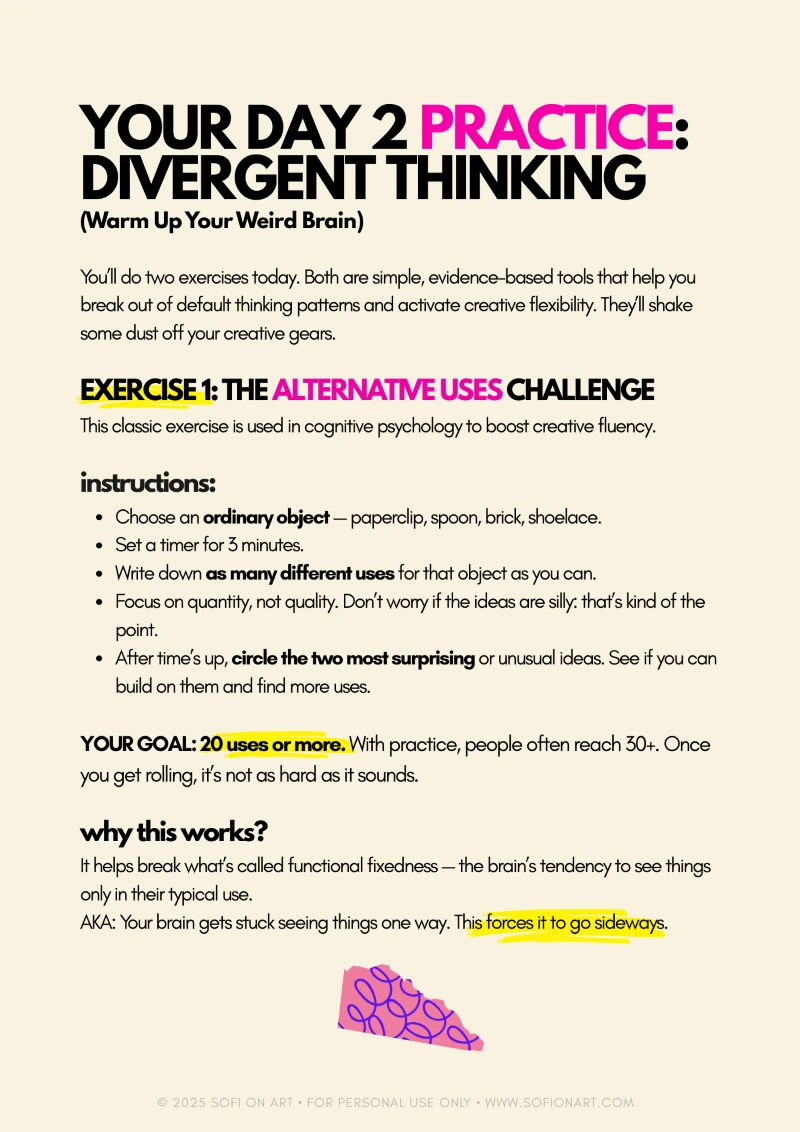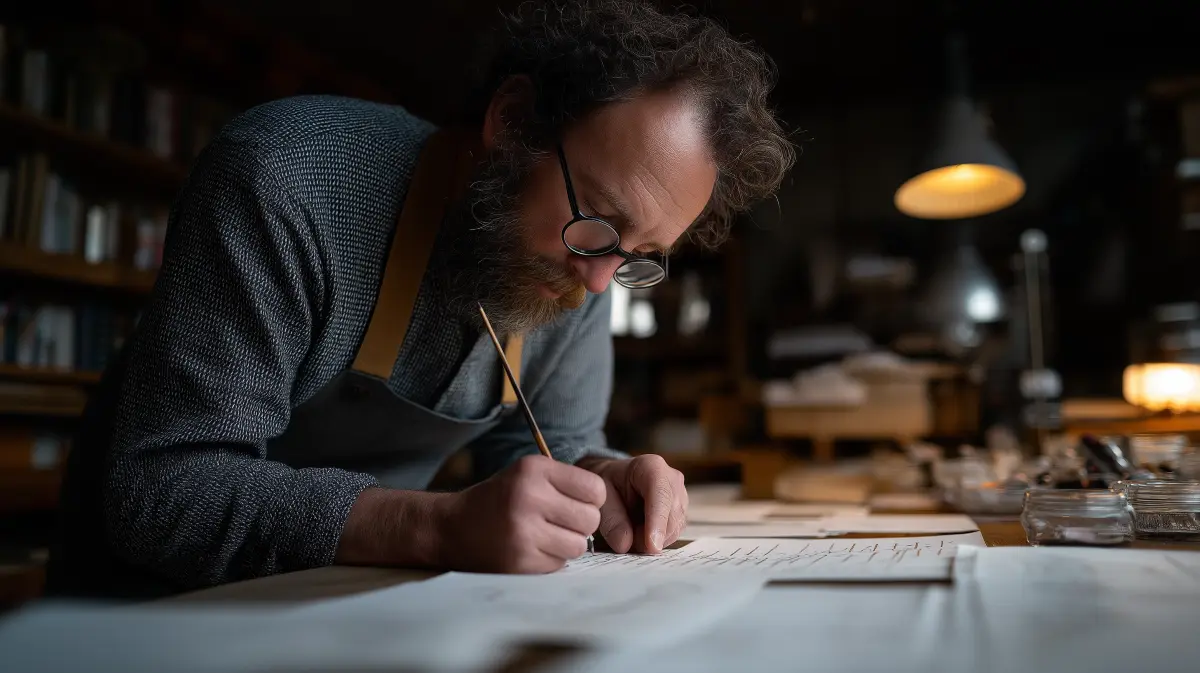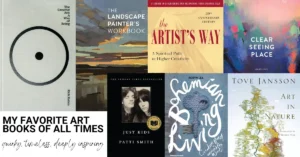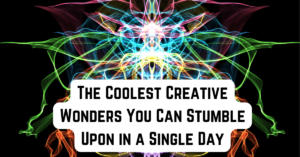Everyone gets stuck.
It doesn’t mean you’re not creative. It doesn’t mean you’re out of ideas.
It means you’re alive — and it means it’s time to move.
Creativity isn’t magic. It’s a combination of imagination, habits, mindset, and environment. And like any living system, sometimes it jams.
The good news is that creative block isn’t permanent. It’s a muscle cramp, not a terminal diagnosis. You simply need to know how to overcome creative block to get going again.
These following creative block exercises show you how serious creators — artists, designers, makers — loosen the gears and get moving.

Why Creative Block Happens
Creative block isn’t about lack of talent.
It’s friction: perfectionism slamming against imagination and stress eating away at curiosity. It is your mind getting caught in tight loops because the environment, the mindset, or the habits haven’t shifted.
When you overjudge every idea, creativity freezes.
When you only work, without rest, the brain burns out.
When you stop feeding your mind with new inputs, it starts running on empty.
Stress tightens it, doubt deepens it, and boredom buries it.
But the brain that can get stuck can also get unstuck, if you know how to work with it.
Simple Creative Block Exercises
Here are some exercises for creative thinking to help you get unstuck. Each of these exercises is backed by research into creativity and cognitive flexibility.
They are simple, powerful tools to shift your brain from rigid to playful, from cautious to exploratory.
You don’t have to do them all.
Pick one.
Start there.
Exercise 1. Make Play Non-Negotiable
Exercise:
Set a 5-minute timer. Make the silliest, ugliest sketch you can. The only rule: it cannot be “good.”
Why it works:
Fear of judgment is creativity’s kryptonite.
When you force yourself to play — really play — you deactivate the inner critic and reactivate your natural curiosity.
Research shows that play fuels divergent thinking, emotional resilience, and spontaneous idea generation.
Without play, the work dries up.
With play, possibilities flood back in.
Exercise 2. Switch to Divergent Mode
Exercise:
Pick any ordinary object — a brick, a paperclip, a spoon — and list 20 different uses for it.
Why it works:
Divergent thinking is the opposite of tunnel vision. It opens your mind to multiple possibilities instead of hunting for one perfect answer.
Creative breakthroughs happen when you make unexpected connections — when you jump sideways, not forward.
This simple game trains your brain to think in clusters, not straight lines.
The more uses you find, the more mental flexibility you build.
And flexibility is the secret sauce of fresh ideas.

Exercise 3. Change Your Environment
Exercise:
Take a 20-minute walk.
No podcasts. No phone. No purpose, except one: notice something you’ve never noticed before — a crack in the sidewalk, a lizard on a wall, a forgotten door.
Why it works:
Moving your body shifts your mental state.
New sensory inputs refresh your mental landscape, triggering what researchers call the “incubation effect” — when ideas bubble up without forced effort.
A Stanford study famously found that walking increased creative output by an average of 60%. Your brain needs new scenery to grow new ideas.
Even tiny shifts — moving your sketchbook to a different table, hanging a new photo on your wall — can jolt you back into creative motion.

Exercise 4. Use Creative Constraints
Exercise:
Challenge yourself with a creative constraint:
Make a painting using only two colors.
Write a poem that doesn’t use the letter “e.”
Design a chair using only recycled materials.
Why it works:
Unlimited freedom can be paralyzing.
Constraints force you to dig deeper. They turn problems into playgrounds.
In fact, most masterpieces are born under constraints — limited time, limited tools, limited resources.
Boundaries don’t kill creativity. It’s the opposite: they sharpen it.
Exercise 5. Borrow a Brain
Exercise:
Play “Idea Ping-Pong” with a trusted friend or fellow artist.
You throw an idea. They bounce back a twist. You build on it. They bend it further.
NB! No judgment allowed.
Why it works:
Creativity thrives on cross-pollination.
Another person’s strange, half-formed idea might be the missing piece you couldn’t see on your own.
Studies show that diverse collaboration sparks better ideas than isolated brainstorming. Fresh minds bring fresh metaphors, fresh questions, fresh paths.
But remember: collaboration needs the right energy. Choose someone who builds, not someone who shoots down.
Exercise 6. Step Away
Exercise:
When you’re grinding with no progress, don’t push harder.
Step away. Bake. Garden. Sleep. Watch clouds.
Why it works:
This is called the incubation effect: your subconscious mind continues working on the problem while your conscious mind rests.
Archimedes had his “Eureka” moment not hunched over parchment, but relaxing in the bath. Creative insight often blooms when you’re not looking directly at the problem.
Scheduling breaks — actual, guilt-free breaks — isn’t laziness, but strategy.

The Mindset Shift Matters Most
You are not either “creative” or “not creative.”
Creativity is expandable, trainable, stretchable — just like strength or speed.
What kills creativity fastest:
Self-doubt
Overjudgment
Perfectionism
Fear of looking foolish
What grows creativity strongest:
Curiosity
Courage
Play
Practice
As Sylvia Plath said, “The worst enemy to creativity is self-doubt.”
Don’t let self-doubt sit at your table. Invite possibility instead.
Creativity asks for persistence, not perfection.
You have to Keep the River Flowing
Not every session will feel electric.
Not every project will turn into gold.
Some days, you’ll sketch junk. You’ll write nonsense. You’ll make a mess.
Good. That’s how the river stays alive.
Creativity is not a tap you turn on when inspiration strikes. It’s a river you keep flowing — sometimes roaring, sometimes trickling — but always moving.
Every act of making, even the small, strange, awkward ones, is a vote for your future self: “I am a person who creates.”
And if you stay in motion, breakthroughs are inevitable.
As Maya Angelou put it:
“You can’t use up creativity. The more you use, the more you have.”

Take One Step Today...
So, how to break through creative block?
Pick one exercise above. Just one. Don’t overthink it.
Move your body. Play badly. Change the rules. Borrow a brain. Read a book about something new and get inspired. Then step away. Let your creative mind stretch out its arms and breathe again.
Because your next great idea is already stirring, just waiting for you to make the first move.
All these creative block exercises, book pages and many more are part of my creativity ebook, which you can now download for free below:





